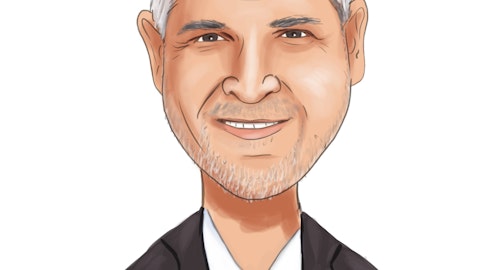Jon Braatz: Okay. You’ve done LNG work before, is this the aspect of this project different than what you’ve done before?
Brett Cope: No, I call it a meat and potatoes, but just a general statement. It’s just the complexity of how the electrical distribution, not just the electrical design, but the mechanical designs, these LNG facilities, they’re being squeezed in the small footprints there on the coastal area, which had a lot of challenges mechanically on the building side. So when you combine the two together, John, it’s just the engineering side of it. It is constant throughout the entire project. And given that our, we carry 10% of our employees are engineers and designers, there’s a lot of changes that happen and we just do it really well, really fast and efficiently. And I don’t think you’re going to be followed that model.
Jon Braatz: Okay. Good. And then lastly, can you talk a little bit about maybe the, if you’re seeing or the prospects I should say, for improving on the international front? Obviously, that’s been geographically a weaker area. Might we see some improvements in 2023?
Brett Cope: Yes, Mike noted in his comments about their sort of the winding down of a couple of projects in Asia. I think we, the end 2021 there was sort of a pause in market activity in terms of where we participate. There are some projects, I just did some touring this fall traveling around in mostly in Asia. And then I’ve got a trip planned for the Middle East in the next year. So we see some things starting to spin back up. And I do think that we’ll come back mid to late next year.
Operator: Our next question will come from John Deysher with Pinnacle.
John Deysher: Good morning. Thanks for taking my question. Following up on the LNG question, have you worked with that customer before?
Brett Cope: Yes, we have.
John Deysher: Okay, so you’ve done projects with them and you understand how each side works. That’s good. What, I don’t know if you can answer this, but looking out to fiscal ’23. what percentage of capacity do you think you might be operating at? Now your sales were close to a record and I know you do some capacity; you sold some operations. But what percentage of capacity do you think you might be operating at in fiscal €˜23?
Brett Cope: John, the first question, firstly, I’d respond your question is the growth and the record backlog that we shared on the call today, as a result of Q4, you’re right to look at it but it is much broader based. And maybe what we’ve seen in the past run up when we saw these sorts of levels. So if you think about €˜12, and €˜13, as we were building Canada, Canada’s participating so and then the UK business, so everybody is spread more evenly. And not just the US Gulf Coast oil and gas. Remember, that market just started coming back really last couple quarters, even though the bidding activity was strong, it’s nice to see it come back, because we were sharing on previous calls that it was getting close, and it’s good to see it get over the edge.
Overall capacity, a little bit timing dependent, because these large projects tend to move around in the schedule. On average, I’d say we’re somewhere in the 60% to 75% range. But we are watching the curves, we are thoughtfully thinking about where we could push that up if we needed to. So I’m pretty confident that with what we have today. And with what we’re looking at in the funnel, we’re well positioned to take the top side of that in the next couple years.
John Deysher: Okay, so you’ve got enough manpower and infrastructure and material sourcing to handle all of this business.
Brett Cope: We do. I mean, if it continues to grow in the pace, it’s at, I wouldn’t say that we’re — we’ll continue to have manpower challenges. But I think some of the changes in the macro side, the consumer side is slowed down this past summer, I’ve seen some indications from our operations, we’ve done a little bit better when we go out into the market and bring in different skill sets, whether it’s in the factory leadership, or even on the engineering side we’re doing I think, a little better overall there. So as I look out if we’re successful at the same pace into the next two years, wouldn’t be without its challenges, but I think we’re well positioned to overcome it and really capitalize it.
John Deysher: That’s helpful. And I guess finally, the new segment, commercial and other industrial, does that replace the all-other segments that you segment out in the financials?




